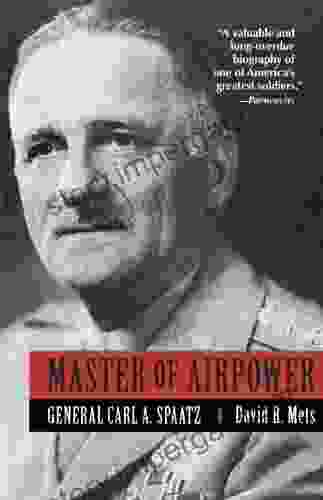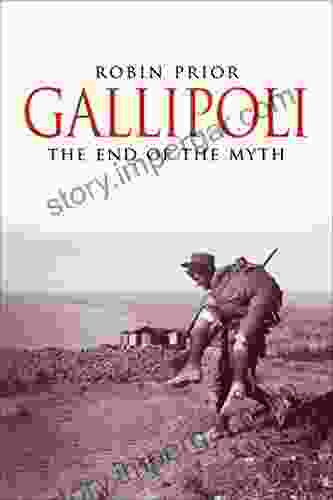Master of Airpower: General Carl Spatz - The Architect of America's Airpower Doctrine

Carl Spatz was a pioneer in the field of airpower, and his ideas continue to influence air warfare today. This book tells the story of his life and career, and provides a detailed analysis of his airpower doctrine.
4.6 out of 5
| Language | : | English |
| File size | : | 6656 KB |
| Text-to-Speech | : | Enabled |
| Enhanced typesetting | : | Enabled |
| Word Wise | : | Enabled |
| Print length | : | 430 pages |
| Screen Reader | : | Supported |
Spatz was born in 1891 and grew up in Pennsylvania. He was fascinated by aviation from a young age, and he learned to fly in 1911. He joined the Army Air Service in 1916, and he served as a pilot in World War I.
After the war, Spatz continued to serve in the Army Air Service. He was a strong advocate for the development of airpower, and he helped to develop the doctrine of strategic bombing. In 1940, he was appointed Chief of Staff of the Army Air Forces.
During World War II, Spatz commanded the air forces in the Pacific. He was responsible for the planning and execution of the bombing campaigns against Japan. He also played a key role in the development of the atomic bomb.
After the war, Spatz served as the first Chief of Staff of the United States Air Force. He retired from the Air Force in 1948.
Spatz was a brilliant military strategist and a visionary leader. He was a pioneer in the field of airpower, and his ideas continue to influence air warfare today. This book is a must-read for anyone who is interested in military history or aviation.
Table of Contents
- Early Life and Career
- World War I
- Interwar Years
- World War II
- Post-War Career
- Legacy
Carl Spatz was a pioneer in the field of airpower, and his ideas continue to influence air warfare today. This book tells the story of his life and career, and provides a detailed analysis of his airpower doctrine.
Spatz was born in 1891 and grew up in Pennsylvania. He was fascinated by aviation from a young age, and he learned to fly in 1911. He joined the Army Air Service in 1916, and he served as a pilot in World War I.
After the war, Spatz continued to serve in the Army Air Service. He was a strong advocate for the development of airpower, and he helped to develop the doctrine of strategic bombing. In 1940, he was appointed Chief of Staff of the Army Air Forces.
Early Life and Career
Carl Spatz was born in Boyertown, Pennsylvania, on June 28, 1891. He was the son of a Lutheran minister and a schoolteacher. Spatz was a bright and ambitious child, and he excelled in school. He graduated from high school at the age of 16 and then attended the University of Pennsylvania.
Spatz was fascinated by aviation from a young age. He built his first model airplane at the age of 12, and he learned to fly in 1911. In 1916, he joined the Army Air Service. He was commissioned as a second lieutenant and assigned to the 1st Aero Squadron.
World War I
Spatz served in World War I as a pilot and a commander. He flew combat missions in France and Italy, and he was awarded the Distinguished Service Cross for his bravery. In 1918, he was promoted to the rank of major and given command of the 94th Aero Squadron.
Spatz's experience in World War I convinced him of the importance of airpower. He believed that airpower could be used to win wars by destroying enemy targets and demoralizing the enemy population. He also believed that airpower could be used to support ground forces and to protect friendly territory.
Interwar Years
After World War I, Spatz continued to serve in the Army Air Service. He was a strong advocate for the development of airpower, and he helped to develop the doctrine of strategic bombing. In 1940, he was appointed Chief of Staff of the Army Air Forces.
As Chief of Staff, Spatz oversaw the expansion of the Army Air Forces. He also developed plans for the use of airpower in a future war. In 1941, he was promoted to the rank of general.
World War II
During World War II, Spatz commanded the air forces in the Pacific. He was responsible for the planning and execution of the bombing campaigns against Japan. He also played a key role in the development of the atomic bomb.
Spatz's leadership was instrumental in the Allied victory in the Pacific. He was a brilliant strategist and a master of airpower. He was also a charismatic leader who inspired his troops to achieve great things.
Post-War Career
After the war, Spatz served as the first Chief of Staff of the United States Air Force. He retired from the Air Force in 1948.
In retirement, Spatz continued to be a vocal advocate for airpower. He wrote several books and articles on the subject, and he lectured extensively. He also served as a consultant to the government and to industry.
Legacy
Carl Spatz was a pioneer in the field of airpower, and his ideas continue to influence air warfare today. He was a brilliant strategist and a master of airpower. He was also a charismatic leader who inspired his troops to achieve great things.
Spatz's legacy is immense. He helped to develop the doctrine of airpower, and he played a key role in the Allied victory in World War II. He also served as the first Chief of Staff of the United States Air Force. Spatz is considered to be one of the most important figures in the history of aviation.
4.6 out of 5
| Language | : | English |
| File size | : | 6656 KB |
| Text-to-Speech | : | Enabled |
| Enhanced typesetting | : | Enabled |
| Word Wise | : | Enabled |
| Print length | : | 430 pages |
| Screen Reader | : | Supported |
Do you want to contribute by writing guest posts on this blog?
Please contact us and send us a resume of previous articles that you have written.
 Book
Book Novel
Novel Page
Page Chapter
Chapter Text
Text Story
Story Genre
Genre Reader
Reader Library
Library Paperback
Paperback E-book
E-book Magazine
Magazine Newspaper
Newspaper Paragraph
Paragraph Sentence
Sentence Bookmark
Bookmark Shelf
Shelf Glossary
Glossary Bibliography
Bibliography Foreword
Foreword Preface
Preface Synopsis
Synopsis Annotation
Annotation Footnote
Footnote Manuscript
Manuscript Scroll
Scroll Codex
Codex Tome
Tome Bestseller
Bestseller Classics
Classics Library card
Library card Narrative
Narrative Biography
Biography Autobiography
Autobiography Memoir
Memoir Reference
Reference Encyclopedia
Encyclopedia Marion Winik
Marion Winik Maxine Harris
Maxine Harris Christine Jacobsen
Christine Jacobsen Mike Clayton
Mike Clayton Tora Johnson
Tora Johnson Raymond S Ihrig
Raymond S Ihrig Matthew J Tuininga
Matthew J Tuininga Marie Claire Ross
Marie Claire Ross Yasmine Ferguson
Yasmine Ferguson Richard Molesworth
Richard Molesworth Tammy Mayhew
Tammy Mayhew Marta Mcdowell
Marta Mcdowell Russell Blackford
Russell Blackford Matthew S Stanford
Matthew S Stanford Marvin L Astrada
Marvin L Astrada Thomas K Holcomb
Thomas K Holcomb Mateus Batista
Mateus Batista Paolo Saraceno
Paolo Saraceno Mark Phillips
Mark Phillips Nikki Leonti Edgar
Nikki Leonti Edgar
Light bulbAdvertise smarter! Our strategic ad space ensures maximum exposure. Reserve your spot today!
 Federico García LorcaFollow ·3.1k
Federico García LorcaFollow ·3.1k Chase MorrisFollow ·19k
Chase MorrisFollow ·19k Ralph TurnerFollow ·12.2k
Ralph TurnerFollow ·12.2k Duncan CoxFollow ·6.4k
Duncan CoxFollow ·6.4k Kurt VonnegutFollow ·13.4k
Kurt VonnegutFollow ·13.4k Virginia WoolfFollow ·18.8k
Virginia WoolfFollow ·18.8k Jamie BellFollow ·15.6k
Jamie BellFollow ·15.6k George BellFollow ·5.8k
George BellFollow ·5.8k

 Roberto Bolaño
Roberto BolañoUnveiling the Beauty and History of the Medici Iris: A...
In the realm of...

 Theodore Mitchell
Theodore MitchellImproving Gut Health in Poultry: Unlocking the Path to...
In the ever-evolving field of...

 Victor Hugo
Victor HugoPersonalized Medicine with a Nanochemistry Twist:...
The future of healthcare...

 George Martin
George MartinA Year Of Wine: Perfect Pairings Great Buys And What To...
## Year of Wine: An Epic Journey Through the...

 Tom Hayes
Tom HayesDelve into the Enigmatic World of Southern Africa's...
Embark on a captivating journey through the...
4.6 out of 5
| Language | : | English |
| File size | : | 6656 KB |
| Text-to-Speech | : | Enabled |
| Enhanced typesetting | : | Enabled |
| Word Wise | : | Enabled |
| Print length | : | 430 pages |
| Screen Reader | : | Supported |














